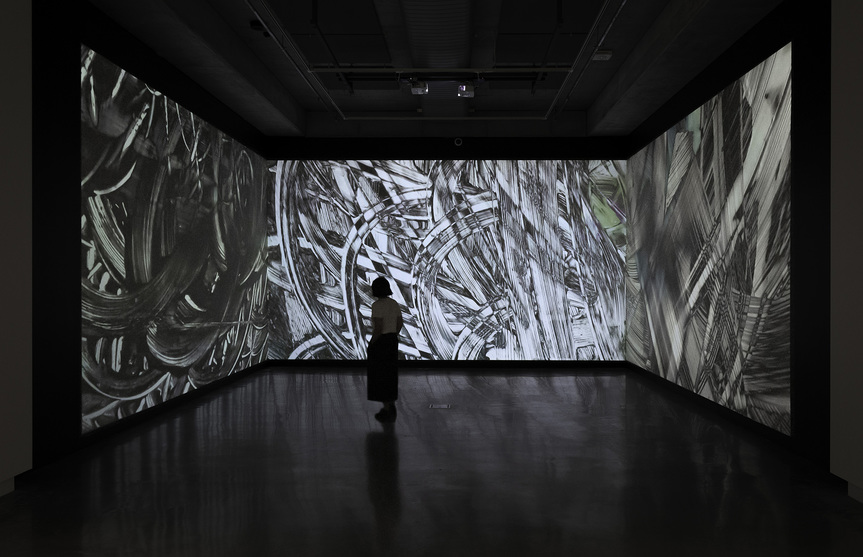-
From Current Issue
-
- Editor’s Letter Fire in the Heart
- Reviews I Gusti Ayu Kadek Murniasih
- Reviews 11th Seoul Mediacity Biennale: “One Escape at a Time”
- Dispatch Networked China
- One on One Monira Al Qadiri on Yukio Mishima
- Essays The rise of independent art spaces in pandemic-era Shanghai
- Features Tuan Andrew Nguyen
- Table of Contents
- Web Exclusives
- Archive
- Subscribe

R
E
V N
E
X
T
Installation view of MIRA GOJAK and TAKEHITO KOGANEZAWA’s “The Garden of Forking Paths” at Buxton Contemporary, the University of Melbourne, 2018–19. Photo by Christian Capurro. Courtesy the artists and Murray White Room, Melbourne.
Buxton Contemporary’s duo exhibition of Japanese artist Takehito Koganezawa and Melbourne-based artist Mira Gojak, “The Garden of Forking Paths,” took its title from the eponymous short story by Argentinian modernist writer Jorge Luis Borges. According to the curatorial statement by co-curators Melissa Keys and Shihoko Iida, it is a “richly multidimensional text that conjures up coexistent but dynamically shifting realms of time and space,” though further reference to the story was absent throughout the exhibition. Left largely unexplained by the curators, the “garden” of Borges’s text serves as a metaphor for the many parallel possibilities that branch out from the timeline of any individual’s existence depending on the various “paths” taken. Drawing on this idea, the exhibition spotlighted the similarities and the points of divergence in Koganezawa and Gojak’s practices, which both delve into the dynamics of time.
Installation view of MIRA GOJAK’s (left to right) Consolation, 2005, wooden wardrobes, mirror, magnets, 2 parts: 250 × 213 × 140 cm; 133 × 140 × 385 cm; Mountain, 2018, wooden wardrobe, acrylic yarn,192 × 110 × 57 cm; Cutting through the vast plain of day, 2018, (detail), archival pigment prints, 12 parts, each 103.5 x 83.5 × 6 cm, at “The Garden of Forking Paths,” Buxton Contemporary, the University of Melbourne, 2018–19. Photo by Christian Capurro. Courtesy the artist and Murray White Room, Melbourne.
At the entrance to the exhibition was Gojak’s abstract sculptural work Prop for Instabilities 2 (2012), inspired by a photograph of the Kenroku-en Garden in Kanazawa, where certain trees branch out horizontally due to the intervention of various elaborate props and suspended structures. The work features two abstracted, jagged, tree-like forms emerging from a freestanding triangular base, while thinner loops and scribble-like twists of wire hang from the ceiling like disconnected tufts of foliage. This precarious juxtaposition of form suspends foliage and pronged trunk in a moment of almost-puncture, foregrounding meditations on instability but also possibility and confluence that appeared throughout the exhibition.
Koganezawa’s Mountains (2009– )—a configuration of 250 paintings that feature flat, block-colored forms ordered across an entire wall—examines stable entities in unexpected ways. Each balanced composition emulates the form of Mount Takao, a key feature in the surrounding landscape during the Japanese artist’s youth. When placed together, Koganezawa’s paintings form a giant, wavelike composition, reflecting the Japanese notion of mountains as dynamic entities. Inspired by this work, Gojak’s new installation Mountain (2018) features a wardrobe choked by a tangle of blue string pulled tight around its center. In spite of its stoic and sturdy materiality, the foreign bindings allude to the repression of interior concerns and introspective struggle. Nearby, Gojak’s deconstructed wardrobe Consolation (2005) is an inverse of Mountain. In this earlier work, wooden slats were removed from three wardrobes, leaving just spindly, structurally vulnerable frames. The slats were then arranged vertically on the floor next to the remnants of the furniture to form a graduated structure. In dialogue, Mountain and Consolation play with exposure and concealment, as well as cycles of construction and deconstruction, permanence and impermanence, decay and rebirth.
Around the corner from these works, Koganezawa’s hypnotic video work Paint it black and erase (2010) visualizes the continuous painting and repainting of a surface. In one wall text he explains that “moving image is a way of addressing the instability of time and existence.” Within the work, Koganezawa appears to constantly rewrite his chosen path in real time, yet this futile gesture fails to noticeably alter the painted surface. Like Borges’s protagonist, who is confronted with notions of inevitability versus choice throughout “The Garden of Forking Paths,” in the video, Koganezawa struggles between chance, possibility and intention.
The Japanese artist’s new video work From warm mud (2018) also takes a conceptual approach to composition, but in a more organic manner devoid of visible human intervention. Under a macro lens, various natural and synthetic substances including oils, pigments and detergents react with, repel and glide past each other in a sumptuous yet visceral display across two 30-minute sequences. Visually cosmic, yet earthly in subject matter, Koganezawa’s work brings attention to elemental collisions that provoke varied outcomes.
Without deeper curatorial insight into Borges’s story, the exhibition’s connection to the text would have risked appearing shallow, if not for the fact that Gojak’s and Koganezawa’s works are complementary in their own right, both utilizing materiality and form to contemplate the immaterial concept of time and its passage.
Mira Gojak and Takehito Koganezawa’s “The Garden of Forking Paths” is on view at Buxton Contemporary, Melbourne, until February 17, 2019.
To read more of ArtAsiaPacific’s articles, visit our Digital Library.


















